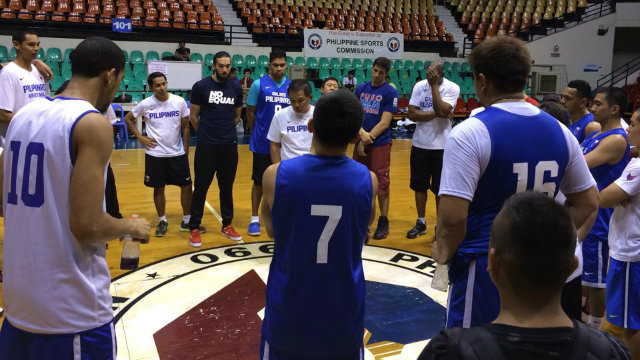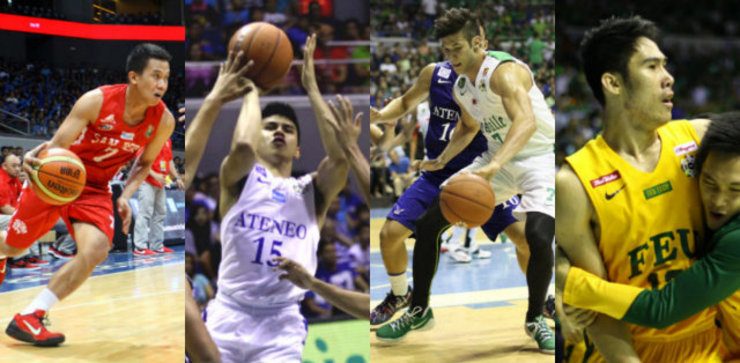SUMMARY
This is AI generated summarization, which may have errors. For context, always refer to the full article.

This piece was supposed to be a little different, but recent developments concerning the Gilas Pilipinas basketball program have conspired, rather serendipitously I might add, to steer this final part of the #GilasIssues series to a slightly different direction.
READ #GilasIssues:
Right now, Gilas Pilipinas, the team that has captured our collective imagination for the past several years is all but a blank slate.
Gilas 1.0 finished top four in the 2011 FIBA Asia. Gilas 2.0 qualified for the FIBA World Cup. How about Gilas 3.0?
We don’t know just yet.
Right now, the SBP and PBA will go through a selection process for all the members of Gilas 3.0, but, let’s face it, this will be a long and winding road mainly because the issues of the team, which have been detailed in previous posts, go beyond faces and personalities.
Pick a Coach
The first spot that should be filled, naturally, is Gilas 3.0’s head coach. Right now I think the following are, generally speaking, the qualifications that should be considered:
– knowledgeable and experienced in dealing with international basketball.
– equipped with a significant number of international contacts who can help with scouting and arranging tune-ups and training programs.
– willing to leave his current coaching position, whether in the pros or collegiate ranks.
– willing to leave his family behind for a significant chunk of time for training and scouting.
– willing to carry the hopes of irrationally basketball-mad Filipinos.
– possesses enough clout to soften certain teams’ collective stance on limiting the players they’ll lend to the national team.
– possesses the track record and repute that will elicit respect, confidence, and loyalty from Gilas’ players.
– brave enough to endure all the stress and scrutiny awaiting him.
– ready to be venerated with every win only to be vilified with every collapse and defeat.
Possible candidates? Well, we can probably tick fan favorites Tim Cone and Yeng Guiao off the list. They’ve gone public with their intention to decline any sort of invitation.
It might also be wise to steer clear of other coaches in the San Miguel Corp. stable, since its rival conglomerate, the Manny V. Pangilinan Group, is Gilas’s major backer. Yes, that’s how we do basketball here in the Philippines (shaking my head).
So, again, any candidates? Any current PBA coaches will, like Cone and Guiao, probably reason out that their commitments to their respective clubs are paramount.
Any UAAP or NCAA coach will probably move under the same parameters. Right off the bat, I’m picking former New Zealand, Lebanon, and Jordan coach Tab Baldwin as a prime candidate, but the very fact he’s not Filipino might turn off some corners. If Jamike Jarin weren’t named San Beda College Head Coach, I would’ve included him, but, well, that won’t happen anymore. Heck, for all we know, Gilas 3.0 might still actually end up with coach Chot, which, in my opinion, wouldn’t be a terrible thing at all.
Pick the Players
Okay, let’s say the SBP and PBA have already chosen a coach for the slaughter, that forsaken individual, whoever he is, will have to almost immediately get down and dirty with naming his player wish list. Coming up with a list is the easy part, of course. Proof? Go to the many basketball forums and Gilas fanpages, and you’ll be treated to a veritable buffet of 12-man rosters or 24-man pools.
Choosing names and plugging them into 12 spots is a cakewalk, but actually prying them away from their club/school teams and getting them to practice WHILE THE SEASON IS ONGOING is a completely different story.
Collegiate standouts like Baser Amer, Kiefer Ravena, Arnold Van Opstal, or Mac Belo? Hell, even if they all wanted to play, it’s very possible that team interests and tournament/school schedules might force them the other way.

Fil-foreigners like Keith Datu, Christian Standhardinger, Moala Tautuaa, Christian David, or Sedrick Barefield? Don’t hold your horses because there are big questions that need to be answered. Did these guys obtain Philippine passports before turning 16? Have they played for any other country before (Standhardinger played for Germany’s youth team in his teens)? Will they simply use their tenure in Gilas to fast-track their application to the PBA? Tricky tricky, indeed.
So we’re left with all of the highly-paid, sometimes pampered pros in the PBA, right? Wrong. That’s because, again, who are we kidding? Whoever the coach is going to be probably won’t be able to pick from the entire PBA lot. On paper, sure, they’ll tell us all that every pro is on the table, but that’s only until the new coach picks three guys from the rival conglomerate’s team and two of those players suddenly come up with a brilliantly flimsy excuse to back out. It’s yet another insane and unneeded constraint on an already constrained program. Well, at least we’re all pretty sure Manny Pacquiao won’t shy away if he’s asked. Even at the expense of his shiny Congressional attendance record, I’m certain he’ll find time to train for Gilas. Sheesh.
Change the Calendar
This is something I’ve told a lot of people – if the Philippines truly wants to hedge its bets in international hoops, then local basketball will have to undergo a MAJOR shift. No, I’m not talking about shortening conferences. I’m talking about aligning ALL our basketball tournaments in reference to the FIBA calendar. This means that amateur leagues (UAAP, NCAA, PCCL, etc.) should be played in the second semester (November to March) instead of the middle months of June to September. Why? Because major FIBA events happen from June to September.
This also means that the PBA should definitely shorten its season. Take note, I said shorten the season, not necessarily cut down on the games. The league can still push through with three conferences (I’m partial to a two-conference format, though), but the schedule will have to be more compressed, like each team plays thrice a week and we’ll have a game every single day. That may even do wonders for our prospective national players, at least in terms of getting used to playing back-to-back games or four-games-in-five-nights.
One of the main disconnects I’ve observed between local hoops and international hoops is that we tend to give too much “recovery time” for our players across games. For instance, it’s par to see a UAAP or NCAA school play just once a week, and the same can be said for the PBA, too. If we want our players to get acclimatized to how FIBA basketball works, then we should not stop at adopting FIBA rules. We have to consider simulating FIBA’s grueling schedule as well. I suggest having a two-conference PBA season that starts in late October and ends in May (note: most Asian basketball leagues end April or early May; the Turkish Airlines Euroleague starts in mid-October and ends in mid-May).
Of course, this will entail several complications. For example, one reason the PBA’s calendar doesn’t coincide with the collegiate hoops calendar is the availability of venues. Imagine if the PBA, UAAP, and NCAA were all playing in the exact same months. Who would get to play in Araneta? The MOA Arena? The San Juan Arena? The Philippine Arena? One solution is having more out-of-town games, which is actually good for simulating the travel that players will have to go through in FIBA tournaments, but the big concerns there are whether all out-of-town venues are up to the PBA’s playing standards and whether they can meet the requirements of TV5’s broadcast infrastructure.
Still, I believe the benefit of drastically shifting the calendar will far outweigh the costs and adjustment period. Changing the calendar is practically inevitable anyway since FIBA is set to impose its “competition windows” as early as 2017. This means Gilas will have to play international basketball RIGHT SMACK IN THE MIDDLE of the PBA and collegiate seasons. The league might as well adjust to it as early as possible to better prepare for the new FIBA qualification system’s full implementation in a few years.
Retain Continuity
One of my main concerns with this whole concept of “rebooting” the Gilas program is that this whole process might be counterintuitive in that it could cut off the program’s continuity. It will be downright surprising and, frankly, wrong for, let’s say, the SBP and PBA to choose a coach with absolutely no ties to the previous iterations of Gilas. It will be even more shocking if, say, most of the players of Gilas 2.0 won’t be kept as members of the next national pool. Ideally, I would love to see guys like June Mar, Japeth, Jared, Jeff, Jayson, RDO, and Ping (among others) retained, while infusing the pool with new blood (e.g. Ravena, AVO, Ray Parks, Troy Rosario, Kobe Paras etc.). You’re probably thinking, “Of course that’s gonna happen. They wouldn’t dare change everything, wouldn’t they?”
My response to that is: Wouldn’t they?
The obvious path is to keep most of what worked and change what didn’t work, but with so many crazy factors conspiring, you never know what’s going to happen. For all we know, the SBP & PBA might blow everything up and revert to the Gilas 1.0 model that was dominated by collegians and sprinkled with a few choice pros.
If we want to succeed in international play, continuity will be key. Make personnel or system changes, sure, but keep a significant number of people who’ve been part of the journey in the past, those who know the ropes and know what it takes to win.
Where will this reboot lead us?
I don’t know. I have this uneasy feeling that this is all still a delayed knee-jerk reaction to the debacle in Incheon.
Will good things come out of this reboot? I sure hope so.
Will bad things come out of it? Inevitably, yes, whether anyone meant for these bad things to happen or not.
It’s still too early in the process, of course. Still too early to tell where this dangerous, risky road will lead. Right now, one can argue that there’s still a lot of time to carefully pick the right personnel for Gilas 3.0, but one can also argue that the same amount of time can be used to completely mess things up.
There’s a whole lot of uncertainty that awaits us all in this Gilas reboot, which, I hope, will eventually lead to a more sizable reboot of the way we do basketball in the Philippines. – Rappler.com
Add a comment
How does this make you feel?
There are no comments yet. Add your comment to start the conversation.